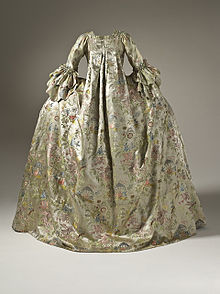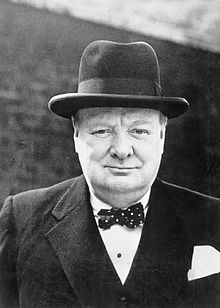Clothes fashion


Dress fashion refers to the fashion in the field of clothing . Conversely, clothing fashion is that part of clothing that is subject to fashion change. In contrast to the traditional term “ Tracht ”, the term clothing fashion describes a short-term customary or appropriate way (or types) of dressing, which is replaced by new fashions at regular intervals due to social change.
Thus, the term clothing fashion also implies an aesthetic meaning of clothing and goes beyond the understanding of clothing as a pure commodity. The term takes into account the fact that clothing not only serves to protect the human body from heat or cold or other impairment from the outside world, but also to make it aesthetic. This includes decorating it (according to different specifications), shaping it, highlighting its advantages or concealing components of the appearance that are perceived as deficiencies, as well as conveying an aesthetic mood, expressing an attitude towards life or making an aesthetic statement.
The taste and the attitude towards many of these aesthetic design motifs are subject to social fashions. Clothing fashion is the collective term for all clothing that is created as a result.
History of fashion
In ancient times they already knew the tunic and the fibula . In the Roman Empire one wore a toga or a stole , there were changing hairdresses; only the emperor was allowed to wear garments dyed with expensive purple . The clothing in the Middle Ages (500–1500) was made of flax fiber or nettle cloth and reflected the order of the class . Towards the end of the Middle Ages, in the 15th century, the imaginative fashion from Burgundy with zaddles and spikes, wide sleeves, hoods or a pointed hennin set the tone for a while. The clothing fashion of the Renaissance and Reformation (1500–1550) knew the doublet , the scarf and, as headgear, the beret . The Spanish fashion garments (1550-1620) favored the corset , the army timpani and the ruff . The clothing fashion at the time of the Thirty Years War (1610–1650) knew the slouch hat and the gauntlet boots . The clothing fashion of the time of Louis XIV (1650–1715) brought the allonge wig and the manteau and France rose to the leading and leading nation in terms of fashion for centuries. The dress mode Rococo (1720-1789) took a liking to Culottes and Contouche , while in the period after the French Revolution in the Revolution and Empire fashion the (1789-1815) fashion à la grecque developed and the men began long trousers wear. The clothing fashion of the Restoration and the Biedermeier (1817–1840) brought the Schute and the patricide . The crinoline fashion (1840-1870) knew the hoop skirt for women. The clothing fashion of the Wilhelminian era up to 1900 (1871–1900) dressed men militarily in an overcoat and the lady in a bodice .
In the twentieth century, many trends followed one another: the French fashion designer Paul Poiret , creator of the so-called hobble skirt (1910/11), was one of the first to break with old conventions by creating dresses that could also be worn without a corset. But this is sometimes attributed to Coco Chanel . The knickers , which had been worn since the 1890s, contributed to a further break-up of traditional gender-specific clothing fashions at the beginning of the 20th century. The time of the First World War brought the trench coat (English trench = trench ); Towards the end of the 1920s and the beginning of the 1930s, increasingly revealing fashion began to prevail, which is largely attributable to the designer Elsa Schiaparelli . In the 1940s the nylon stockings came and as the needs of the customers became more "minimalistic" by the Second World War, in the 1950s creations like the jeans and the T-shirt experienced a big trend. In the 1960s, the mini skirt propagated by Mary Quant accompanied the progressive sexual liberation . The 20th century was far from over with the advent of hot pants . Clothing fashion can also mean not wearing any clothes at all (see nudism , nude look ) or leaving the upper body uncovered (see above ).
As a result, clothing fashion represents a component and a mode of expression of the umbrella term fashion , which describes the total amount of prevailing behavior, thought and design patterns.
Museums
Today, the Galleria del custume in Florence , the Metropolitan Museum of Art in New York , the Victoria and Albert Museum in London and the Musée Galliera in Paris document fashion history. In Germany, one of the largest collections of fashion from the first eight decades of the 20th century, which Josefine Edle von Krepl has compiled, is on display in Meyenburg Castle .
education
The tailor traditionally makes clothes. You can then study fashion design . In London, for example, there is the Central Saint Martins College of Art and Design , in Munich the German Master School for Fashion .
Fashion designer
Well-known German fashion designers were and are for example: Gabriele Strehle , Anja Gockel , Karl Lagerfeld , Tomas Maier ; in Italy Giorgio Armani and Miuccia Prada ; in France Jean Paul Gaultier and Christian Dior ; in the United States Oleg Cassini and Ralph Lauren ; in Russia Slava Saizew .
measure up
In Europe, Düsseldorf is the fashion fair city with the highest turnover; Here is the Igedo operates. There is also the Bread & Butter trade fair . Berlin Fashion Week has been established since 2007 . In Italy there is the Milan Fashion Week , in the USA the New York Fashion Week , in France the Fashion Week de Paris .
marketing
The fashion photography marketed fashion by Models sold: Familiar faces were and are Claudia Schiffer , Marcus Schenkenberg , Toni Garrn , in Brazil Gisele Bundchen .
Textile industry
The clothing industry uses the human desire for variety for promotional purposes and regularly designs and produces new textiles that are appropriate to the season. By changing colors, materials and models, consumers want to exchange the old, perhaps not yet worn and still fitting items of clothing for new ones in order to obey the dictates of fashion.
Fashion designers develop drafts (at least) every six months. They are presented as coordinated collections by models at fashion shows or trade fairs nine months before the start of the season. Often the work here is very artistic and experimental (not just for attention). As a result, new styles are presented very consistently and radically and the proposed innovations are made very clear and clear.
The textile industry and the textile trade are inspired by this and adopt the current ideas (color, pattern, cut, material) and develop more moderate designs from them that are "wearable" for the mass market. Today these are largely produced cheaply in low-wage countries and sold in Europe at the beginning of the season. Fashion chains like H&M put several collections on the market each season and can thus adapt to short-term trends . The European textile industry suffers from production in low-wage countries .
Even before clothing fashions are propagated by fashion designers, fashion companies and fashion houses, new aesthetic developments are heralded in society, especially among innovative, adventurous and socially critical population groups. It is not uncommon for fashion companies to track down these trends using trend scouts ( coolhunting ) and be inspired by them in their designs.
These groups, as well as fashion designers and trendsetters, play a key role in the diffusion and success of any new fashions proposed by the designers.
Motivations to wear fashionable clothes
- Desire for variety
- Need to adapt, not to attract attention: conformism by wearing the fashion already established in the reference group; Need for adjustment due to uncertainties in aesthetic or other questions
- Need for differentiation, desire to experiment with fashion, to impress, to stand out from the crowd, status symbol : wearing the new fashion that is not yet established in the reference group; Show that you are up to date, creative, innovative etc .; Wearing very rare, individual and expensive fashions; Display of social rank
Quotes
- "You know, Phipps, fashion is what you wear yourself. What others wear is tasteless." ( Oscar Wilde )
- "I am against fashion that is fleeting. I cannot accept that clothes are thrown away just because it is spring." ( Coco Chanel )
- "Do not dress under and not over your class; neither over nor under your wealth; not fantastic; not colorful; not without necessity magnificent, shiny nor precious; but neat, tasteful, and where you have to make an effort, there is your effort solid and beautiful at the same time. Do not distinguish yourself with old-fashioned clothing or clothing that imitates all newfangled folly. Pay a little more attention to your suit if you want to appear in the big world. One is upset in society as soon as one is conscious of one uncomfortable outfitting. " - Adolph Freiherr von Knigge , general remarks and regulations on dealing with people
- "Fashion is such an unbearable form of ugliness that we have to change it every six months." (Oscar Wilde)
- "Fashion is not just a question of clothing . Fashion has to do with ideas, with how we live." (Coco Chanel)
- " Style is superior to fashion. It lets itself be inspired by fashion and takes up its ideas without adopting them entirely. Nobody with a style consciousness would radically change their way of dressing just for the sake of fashion. What style of fashion the difference is the quality. " ( Giorgio Armani )
Others
The hat fashion , more precisely the wearing of headgear , was the piece of clothing that was the longest lasting clothing fashion in Western culture from the 10th to the 20th century.
See also
literature
- Gertrud Lehnert: Fashion. A crash course . Updated new edition DuMont, Cologne 2003, ISBN 978-3-8321-9123-8 .
- NJ Stevenson: The history of fashion: styles, trends and stars (original title: The Chronology of Fashion , translated by Waltraud Kuhlmann and Birgit Lamerz-Beckschäfer), Haupt, Bern / Stuttgart / Vienna 2011, ISBN 978-3-258-60032- 1 .
- Jutta Sywottek: Can we talk about fashion now? Clothing and textile industry in post-war Germany . Arete Verlag, Hildesheim 2014. ISBN 978-3-942468-22-0 .
- Barbara Schmelzer-Ziringer: Mode Design Theory , Böhlau Verlag / Uni-Taschenbücher-Verlag, Cologne / Weimar / Vienna 2015, ISBN 9783825244033
Web links
- The fashion dictionary Glossary of fashion language by Burkhard Treude
- La Couturière Parisienne Comprehensive information on fashion history
- Modeszene Online magazine from the Goethe Institute about the German fashion scene
Individual evidence
- ↑ Developments in the world of fashion ( Memento of the original from September 23, 2012 in the Internet Archive ) Info: The archive link was automatically inserted and not yet checked. Please check the original and archive link according to the instructions and then remove this notice.
- ↑ At the fashion countess . In: Deutschlandfunk . ( deutschlandfunk.de [accessed November 25, 2018]).
- ↑ Coco-Chanal Quotes




